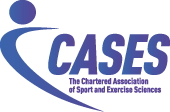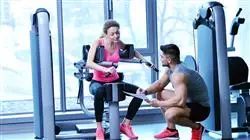University certificate
Scientific endorser

Scientific endorser

The world's largest faculty of sports science”
Introduction to the Program
Improve your knowledge in Strength Training for Sports Performance with this high-level program”

In recent years, strength training has burst with great impetus in the scientific community, covering multiple contexts, ranging from sports performance in time and brand sports, to situational sports, through the whole range of sports modalities.
This Masters Degree addresses the vital importance of strength in human performance in all its possible expressions with a unique level of theoretical depth and a level of descent to the practical totally differentiating with respect to what has been seen so far.
The students of this Masters Degree will have a differentiating qualification with respect to their professional colleagues, being able to perform in all areas of sport as a specialist in Strength Training.
The teaching team of this Masters Degree in Strength Training for Sports Performance has made a careful selection of each of the topics of this program, in order to offer the student the most complete study opportunity possible and always linked to current events.
As such, TECH Global University has set out to create contents of the highest teaching and educational quality that will turn students into successful professionals, following the highest quality standards in teaching at an international level.
Therefore, we is displayed in this Masters Degree with a rich content that will help the student reach the elite of physical training. In addition, as it is an online Masters Degree, the student is not bound by fixed schedules or the need to move to another physical location, rather, they can access the content at any time of the day, balancing their professional or personal life with their academic life.
Immerse yourself in this Masters Degree with high scientific rigor and improve your skills in strength training for high performance sports"
This Masters Degree in Strength Training for Sports Performance contains the most complete and up-to-date scientific program on the market. The most important features include:
- The development of numerous case studies presented by specialists in personal training
- The graphic, schematic and practical contents of the course are designed to provide all the essential information required for professional practice
- Exercises where the self-assessment process can be carried out to improve learning
- Algorithm-based interactive learning system for decision making
- Special emphasis on innovative methodologies in personal training
- Theoretical lessons, questions to the expert, debate forums on controversial topics, and individual reflection assignments
- Content that is accessible from any fixed or portable device with an Internet connection
This Masters Degree is the best investment you can make when selecting a refresher program, for two reasons: in addition to updating your knowledge as a personal trainer, you will obtain a degree from TECH Global University"
The teaching staff includes professionals from the field of sports science, who bring their experience to this training program, as well as renowned specialists from leading societies and prestigious universities.
The multimedia content, developed with the latest educational technology, will provide the professional with situated and contextual learning, i.e., a simulated environment that will provide immersive education programmed to learn in real situations.
This program is designed around Problem-Based Learning, whereby the professional must try to solve the different professional practice situations that arise during the course. In order to do so, the professional will have the help of an innovative interactive video system made by recognized experts in Strength Training for Sports Performance and with great experience.
This Masters Degree offers education in simulated environments, which provides an immersive learning experience designed to prepare for real-life situations"

This 100% online Masters Degree will allow you to balance your studies with your professional work while increasing your knowledge in this field"
Why study at TECH?
TECH is the world’s largest online university. With an impressive catalog of more than 14,000 university programs available in 11 languages, it is positioned as a leader in employability, with a 99% job placement rate. In addition, it relies on an enormous faculty of more than 6,000 professors of the highest international renown.

Study at the world's largest online university and guarantee your professional success. The future starts at TECH”
The world’s best online university according to FORBES
The prestigious Forbes magazine, specialized in business and finance, has highlighted TECH as “the world's best online university” This is what they have recently stated in an article in their digital edition in which they echo the success story of this institution, “thanks to the academic offer it provides, the selection of its teaching staff, and an innovative learning method aimed at educating the professionals of the future”
A revolutionary study method, a cutting-edge faculty and a practical focus: the key to TECH's success.
The most complete study plans on the university scene
TECH offers the most complete study plans on the university scene, with syllabuses that cover fundamental concepts and, at the same time, the main scientific advances in their specific scientific areas. In addition, these programs are continuously being updated to guarantee students the academic vanguard and the most in-demand professional skills. In this way, the university's qualifications provide its graduates with a significant advantage to propel their careers to success.
TECH offers the most comprehensive and intensive study plans on the current university scene.
A world-class teaching staff
TECH's teaching staff is made up of more than 6,000 professors with the highest international recognition. Professors, researchers and top executives of multinational companies, including Isaiah Covington, performance coach of the Boston Celtics; Magda Romanska, principal investigator at Harvard MetaLAB; Ignacio Wistumba, chairman of the department of translational molecular pathology at MD Anderson Cancer Center; and D.W. Pine, creative director of TIME magazine, among others.
Internationally renowned experts, specialized in different branches of Health, Technology, Communication and Business, form part of the TECH faculty.
A unique learning method
TECH is the first university to use Relearning in all its programs. It is the best online learning methodology, accredited with international teaching quality certifications, provided by prestigious educational agencies. In addition, this disruptive educational model is complemented with the “Case Method”, thereby setting up a unique online teaching strategy. Innovative teaching resources are also implemented, including detailed videos, infographics and interactive summaries.
TECH combines Relearning and the Case Method in all its university programs to guarantee excellent theoretical and practical learning, studying whenever and wherever you want.
The world's largest online university
TECH is the world’s largest online university. We are the largest educational institution, with the best and widest online educational catalog, one hundred percent online and covering the vast majority of areas of knowledge. We offer a large selection of our own degrees and accredited online undergraduate and postgraduate degrees. In total, more than 14,000 university degrees, in eleven different languages, make us the largest educational largest in the world.
TECH has the world's most extensive catalog of academic and official programs, available in more than 11 languages.
Google Premier Partner
The American technology giant has awarded TECH the Google Google Premier Partner badge. This award, which is only available to 3% of the world's companies, highlights the efficient, flexible and tailored experience that this university provides to students. The recognition as a Google Premier Partner not only accredits the maximum rigor, performance and investment in TECH's digital infrastructures, but also places this university as one of the world's leading technology companies.
Google has positioned TECH in the top 3% of the world's most important technology companies by awarding it its Google Premier Partner badge.
The official online university of the NBA
TECH is the official online university of the NBA. Thanks to our agreement with the biggest league in basketball, we offer our students exclusive university programs, as well as a wide variety of educational resources focused on the business of the league and other areas of the sports industry. Each program is made up of a uniquely designed syllabus and features exceptional guest hosts: professionals with a distinguished sports background who will offer their expertise on the most relevant topics.
TECH has been selected by the NBA, the world's top basketball league, as its official online university.
The top-rated university by its students
Students have positioned TECH as the world's top-rated university on the main review websites, with a highest rating of 4.9 out of 5, obtained from more than 1,000 reviews. These results consolidate TECH as the benchmark university institution at an international level, reflecting the excellence and positive impact of its educational model.” reflecting the excellence and positive impact of its educational model.”
TECH is the world’s top-rated university by its students.
Leaders in employability
TECH has managed to become the leading university in employability. 99% of its students obtain jobs in the academic field they have studied, within one year of completing any of the university's programs. A similar number achieve immediate career enhancement. All this thanks to a study methodology that bases its effectiveness on the acquisition of practical skills, which are absolutely necessary for professional development.
99% of TECH graduates find a job within a year of completing their studies.
Master's Degree in Strength Training for Sports Performance
.
It is well known that the skill of the muscles to leave an unequaled mark on the court, track or ring is proportional to the rigor of training, but managing parameters linked to thermodynamics, bioenergetics and motor divergence or knowing the methods of Zatsiorsky to optimize physical abilities, is something that perhaps many are unaware of. At TECH Global University we prepare you intensively so that you can use these and many other valuable concepts with our Master's Degree in Strength Training for Sports Performance, a postgraduate program taught by notable experts in the field that seeks to provide graduates in the field of physical education an opportunity to move up the professional ladder. Thanks to our unique system of asynchronous classes where high-level digital technology and the most efficient higher education models in the international market converge, we provide you with 100% online training that will help you take that definitive leap to success.
Improve sports performance with strength training
.
Barriers are merely mental. This apothegm is something often repeated by athletes as a way to challenge themselves in a plan of continuous self-improvement. The interesting thing about the philosophy behind these words is that it is not simply a metaphor. There are recorded feats in the world of sport that blur the boundaries between reality and fiction; such as the case of Elbrus Nigmatullin: a Russian strength athlete capable of lifting helicopters and dragging 36-ton airplanes. It's not just about training, it's about knowing how to do it. Thanks to a Master's Degree like this one, you will be able to learn different guidelines that will lead you to the podium without fear of failure. In the course of ten modules, you will learn from exercise physiology to training applied to medium and long duration sports such as cycling. In TECH you will find that growth impulse that will exceed your expectations. Don't miss out on enrolling.







